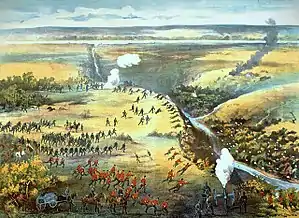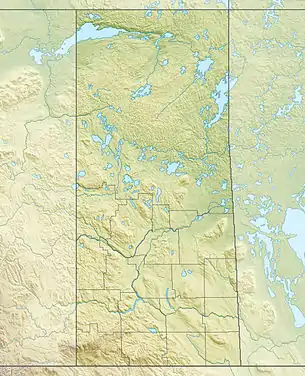Battle of Fish Creek
The Battle of Fish Creek (also known as the Battle of Tourond's Coulée ),[4] fought April 24, 1885 at Fish Creek, Saskatchewan, was a major Métis victory over the Canadian forces attempting to quell Louis Riel's North-West Rebellion. Although the reversal was not decisive enough to alter the ultimate outcome of the conflict, it was convincing enough to persuade Major General Frederick Middleton to temporarily halt his advance on Batoche, where the Métis would later make their final stand.
| Battle of Fish Creek | |||||||
|---|---|---|---|---|---|---|---|
| Part of the North-West Rebellion | |||||||
 Contemporary lithograph of the Battle of Fish Creek | |||||||
| |||||||
| Belligerents | |||||||
| Metis, Cree, Teton Sioux rebels |
| ||||||
| Commanders and leaders | |||||||
| Gabriel Dumont | Frederick Middleton | ||||||
| Strength | |||||||
| 280[1] | 900 | ||||||
| Casualties and losses | |||||||
|
11 Métis & Dakota dead[1][2] 18 wounded[1] |
10 dead[3] 40 wounded[3] | ||||||
| Official name | Battle of Tourond's Coulee / Fish Creek National Historic Site of Canada | ||||||
| Designated | 1923 | ||||||
The Métis conflict area is circled in black.
Battle
Middleton, having led his Field Force out from Qu'Appelle on April 10, was advancing upstream from Clarke's Crossing along the South Saskatchewan River when he discovered a hastily organized ambush by Gabriel Dumont's Métis / Dakota force.
Dumont suggested to Riel the use of guerrilla warfare, by blowing up train tracks to disallow them from crossing over into certain parts of Eastern Canada. Riel stated that guerrilla tactics was "too much like Indian warfare".[5] Dumont also proposed to surprise attack them at night, but after Dumont heard that Middleton's scouts were already on the lookout, Dumont had to scrap that idea.[5]
On April 23, as the militia began advancing from Clarke's Crossing, Dumont took 200 men and rode out from Batoche toward Tourond's Coulée. Louis Riel accompanied them. When a (false) report arrived that the North-West Mounted Police were advancing on Batoche, Riel returned there with 50 men. Dumont stationed most of his men in the coulée, where they set to work digging rifle pits. Dumont took a smaller party of twenty horsemen forward of the coulée. Their task was to seal the exit when the ambush was sprung. "I want to treat them like buffaloes," Dumont said of Middleton's men. However, an inexperienced Metis soldier had forgotten Dumont's specific demand to stay away from the road as it could give the location of the Metis away. The next day, the militia were about to attempt to cross the coulée. A scout spotted the tracks of the inexperienced Metis soldier and began to follow them. The scout was coming close to Dumont and his men in which Dumont stealthily attempted to catch him. Before Dumont could catch the scout, the Metis and Canadian army had come into contact with each other, and it was then that the concealed Métis in the rifle pits would attempt to ambush the militia. Dumont, under pressure, shot the militia's scout and returned to his men in the poplar bluff rifle pits to fight the rest of the Canadian militia.[6][7]
The Métis pounded Middleton's men with one devastating fusillade before withdrawing into cover and restricting themselves to sniper fire in order to conserve ammunition. Their position was strategically selected and enabled a simple and effective strategy of defence.
Since the Métis were positioned in the coulée, Métis soldiers were restricted to shooting up towards the Canadian army in which many of the casualties and wounds were mainly in the upper body and head area.[8]
With half of his force on the opposite side of the river, Middleton was unable to bring his full numerical army to bear. One of his artillery batteries opened fire on the Métis to little effect, although well-fired cannonades did succeed in driving away Dumont's Cree allies before their weight could be added to the battle.
Many of Dumont's men were fleeing the battle. Dumont stopped as many men as he could from leaving and convinced them to keep fighting. Dumont's numbers were decreasing vastly as he had forty-seven of the one hundred and thirty men that he began fighting with. Dumont very outnumbered, but was able to keep the Metis casualties to a minimum.[7]
Strung out along the coulée's edge, silhouetted against the sky, the militia fired a vast amount of ammunition at the resistance, succeeding mostly in showering tree branches across the ravine, but when the artillerymen pushed their guns to the coulée's edge to try to fire down at the concealed Métis, they suffered heavy casualties.[9] The only targets the militia could clearly see were the Métis' tethered horses. They slaughtered about fifty-five of the horses.[10]
General Middleton attempted to place himself in full view of the resistance. However, a bullet tore through his fur hat, and his two aides-de-camp were both wounded by his side. The frustrated Canadians, their casualties mounting, undertook several fruitless rushes into the ravine. A few infantry regulars under Middleton's command made one charge. Another, larger one was carried out by the Royal Winnipeg Rifles militia. This latter advance was parried by the Métis' use of improvised barricades within the coulée. These uncoordinated advances accomplished nothing but more Canadian casualties. Middleton in a statement later on said: "[Métis] plans were well arranged beforehand and had my scouts not been well to the front we should have been attacked in the ravine and probably wiped out".[5][11]
Despite the heavy casualties inflicted upon the resistance, Métis morale deteriorated as the battle wore on. Dumont's men were famished, dehydrated, and low on ammunition (conditions that had plagued them throughout the rebellion), though relatively impervious to enemy fire from within their gullies and ravines.
However, Middleton, distressed by the casualties he was taking, erred on the side of caution and opted for retreat. At the battle's end, both sides had withdrawn from the battlefield but the Métis had inflicted greater casualties and had delayed Middleton's march on the Metis' headquarters at Batoche.[12] Weeks later, after news reached him of the Cree victory over Colonel Otter – to whom had been issued the dreaded Gatling gun – at Cut Knife, Middleton embarked once more on decisive action against Batoche.
Maps
Legacy
—National Historic Sites and Monuments Board[13]
The site of the battle was designated a National Historic Site of Canada in 1923.[14]
In the spring of 2008, Tourism, Parks, Culture and Sport Minister Christine Tell proclaimed in Duck Lake, that "the 125th commemoration, in 2010, of the 1885 Northwest Resistance is an excellent opportunity to tell the story of the prairie Métis and First Nations peoples' struggle with Government forces and how it has shaped Canada today."[15]
The Battle of Fish Creek National Historic Site, now named Tourond's Coulée / Fish Creek National Historic Site, preserves the battlefield of April 24, 1885 at la coulée des Tourond , and the story of Madame Tourond's home. The National Historic site of Middleton's camp and graveyard is across the Fish Creek water body and is north west of the theatre of battle which occurred in the creek valley west of the Tourond farmhouse site.[16]
See also
- List of battles won by Indigenous peoples of the Americas
Footnotes
- Panet, Charles Eugène (1886). Report upon the suppression of the rebellion in the North-West Territories and matters in connection therewith, in 1885: Presented to Parliament. Ottawa: Department of Militia and Defence. p. 20.
- Barkwell, Lawrence J. (2010). "Heroes of the 1885 Northwest Resistance. Summary of those Killed". Louis Riel Institute. Retrieved 13 November 2013.
- Panet (1886), p. xi
- "Famous 1885 Battle Site Gains New Name" (Press release). Ottawa: Parks Canada. 17 November 2007.
- Woodstock, George (1978). Gabriel Dumont. Don Mills, Ontario: Fitzhenry & Whiteside. ISBN 0889022399.
- Morton, Desmond (1972). The Last War Drum: The North West Campaign of 1885. Canadian War Museum Historical Publications. Volume 5. Toronto: Hakkert. p. 62.
- "The Battle of Batoche: British Small Warfare and the Entrenched Métis" (PDF). The Battle of Batoche by Hildebrandt, Walter. Parks Canada, Winnipeg. 1985. Retrieved 2013-11-13.
- Carnie , L. R. (1935). Reminiscence Early Days In Battleford and With Middleton's Columns. Saskatchewan, ON: The Herald.
- Beal & Macleod (1994), pp. 230-231.
- Morton (1972), pp. 64-65.
- Mulvany, Charles Pelham (1886). The History of the North-west Rebellion of 1885. Toronto: A.H. Hovey. pp. 131–132, 141.
- Beal, Bob; Macleod, Rod (7 February 2006). "North West Rebellion". The Canadian Encyclopedia. updated 19 February 2019 by Richard Foot and Eli Yarhi (online ed.). Historica Canada.
- "Fish Creek Plaque". Gabriel Dumont Institute of Native Studies and Applied Research. 1933.
- Battle of Tourond's Coulee / Fish Creek. Canadian Register of Historic Places. Retrieved 6 August 2012.
- "Tourism agencies to celebrate the 125th anniversary of the Northwest Resistance/Rebellion". Home/About Government/News Releases/June 2008. Government of Saskatchewan. 7 June 2008. Archived from the original on 21 October 2009. Retrieved 20 September 2009.
- "Battle of Fish Creek". National Parks and National Historic Sites of Canada. Her Majesty the Queen in Right of Canada, represented by the Chief Executive Officer of Parks Canada. 2007. Retrieved 20 September 2009.
References
- "Battle of Fish Creek". National Parks and National Historic Sites of Canada. Her Majesty the Queen in Right of Canada, represented by the Chief Executive Officer of Parks Canada. 2007. Retrieved 20 September 2009.
- Battle of Tourond's Coulee / Fish Creek. Canadian Register of Historic Places. Retrieved 6 August 2012.
- Beal, Bob; Macleod, Rod (7 February 2006). "North West Rebellion". The Canadian Encyclopedia. updated 19 February 2019 by Richard Foot and Eli Yarhi (online ed.). Historica Canada.
- Carnie, L. R. (1935). Reminiscence Early Days In Battleford and With Middleton's Columns. Saskatchewan, ON: The Herald.
- "Famous 1885 Battle Site Gains New Name" (Press release). Ottawa: Parks Canada. 17 November 2007.
- Panet, Charles Eugène (1886). Report upon the suppression of the rebellion in the North-West Territories and matters in connection therewith, in 1885: Presented to Parliament. Ottawa: Department of Militia and Defence. p. 20.
- Morton, Desmond (1972). The Last War Drum: The North West Campaign of 1885. Canadian War Museum Historical Publications. Volume 5. Toronto: Hakkert. p. 62.
- Mulvany, Charles Pelham (1886). The History of the North-west Rebellion of 1885. Toronto: A.H. Hovey. pp. 131–132, 141.
- "The Battle of Batoche: British Small Warfare and the Entrenched Métis" (PDF). The Battle of Batoche by Hildebrandt, Walter. Parks Canada, Winnipeg. 1985. Retrieved 2013-11-13.
- "Tourism agencies to celebrate the 125th anniversary of the Northwest Resistance/Rebellion". Home/About Government/News Releases/June 2008. Government of Saskatchewan. 7 June 2008. Archived from the original on 21 October 2009. Retrieved 20 September 2009.
- Woodstock, George (1978). Gabriel Dumont. Don Mills, Ontario: Fitzhenry & Whiteside. ISBN 0889022399.
